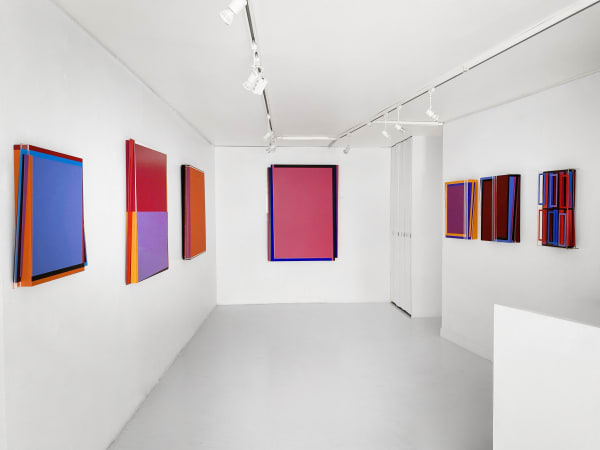Sensitive and sober, the work of Ugarte is the fruit of a coherent reflection and a rigorous discipline. Based on the concept of structure, his paintings, executed on canvas and wood, reveal a simple configuration: the use of pure forms (square and rectangle) and the line in an alternative and repetitive way. Ugarte is developing a network of lines that cross the board horizontally, vertically and diagonally. The diagonal that he uses in a systematic way allows him to accentuate the dynamism of the work. Through this network of lines, orthogonal shapes determined by solid colors appear.
Nevertheless, this rigorous geometrical structure which gives the painting an impression of balance and visual unity, is none the less illusory. It is the imbalance, the asymmetry, the destructuring that the artist seeks in his work. So he plays with ambiguity and dynamics to acquire a greater presence in space and come to a new reading, a discontinuous reading of his work.
Educated at the School of Fine Arts in Valencia, Venezuela, René Ugarte was particularly inspired by the abstract art of Casimir Malevitch, founder of Suprematism, but also by the painters of neoplasticism by Piet Mondrian and Theo van Doesburg. Within these abstract and constructive concepts to which Ugarte refers, "he has found remarkable solutions to the problem of the ambiguous perception of pictorial space by combining the two-dimensional with superimposed volumes". His integration into the artistic milieu of the time is also encouraged by the presence of Venezuelan artists, Jesús Rafael Soto and Carlos Cruz Diez, great kinetic masters for whom he worked.
-

Structure of movement
AGAM / MERIDA / REUSSNER / SALAZAR / STRACK / UGARTE 22 Oct 2025 - 1 Jan 2026Galerie Meyer Zafra is pleased to present Structures of Movement, a group exhibition bringing together six artists, Yaacov Agam, Manuel Mérida, Jean-Claude Reussner, Francisco Salazar, Walter Strack and René Ugarte...Read more -

René Ugarte
Structures et Convergences 27 Mar - 2 May 2025Espace Meyer Zafra is pleased to present “Structures and Convergences”, a solo exhibition by Venezuelan artist René Ugarte. From March 27 to May 1, 2025, the exhibition will bring together...Read more -

The 100th Show
29 May - 28 Jun 2024Espace Meyer Zafra is pleased to present “The 100th Show”, the 100th show at the gallery bringing together the works of Marina Apollonio, Ennio L. Chiggio, Alexis Hayère, Piotr Kowalski,...Read more







